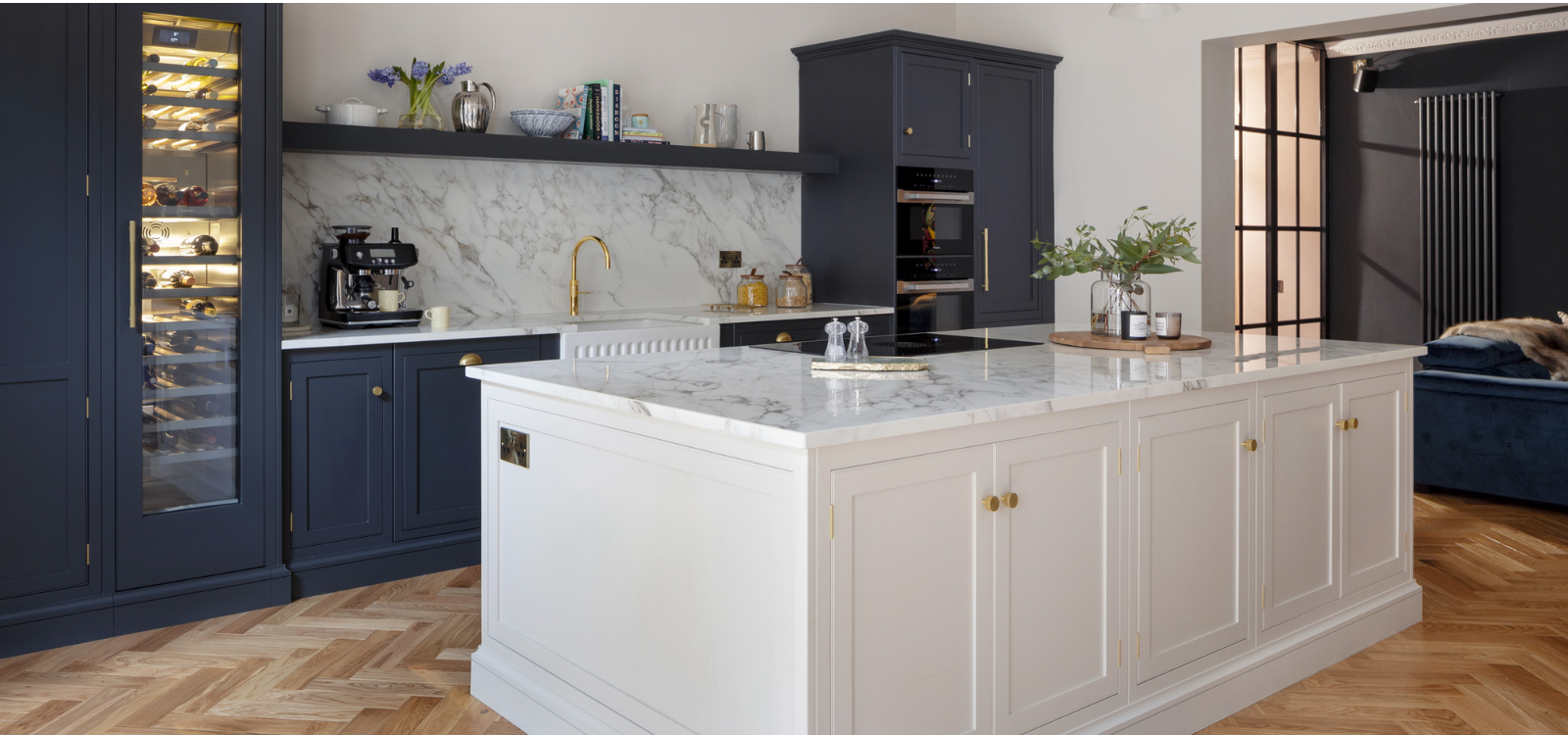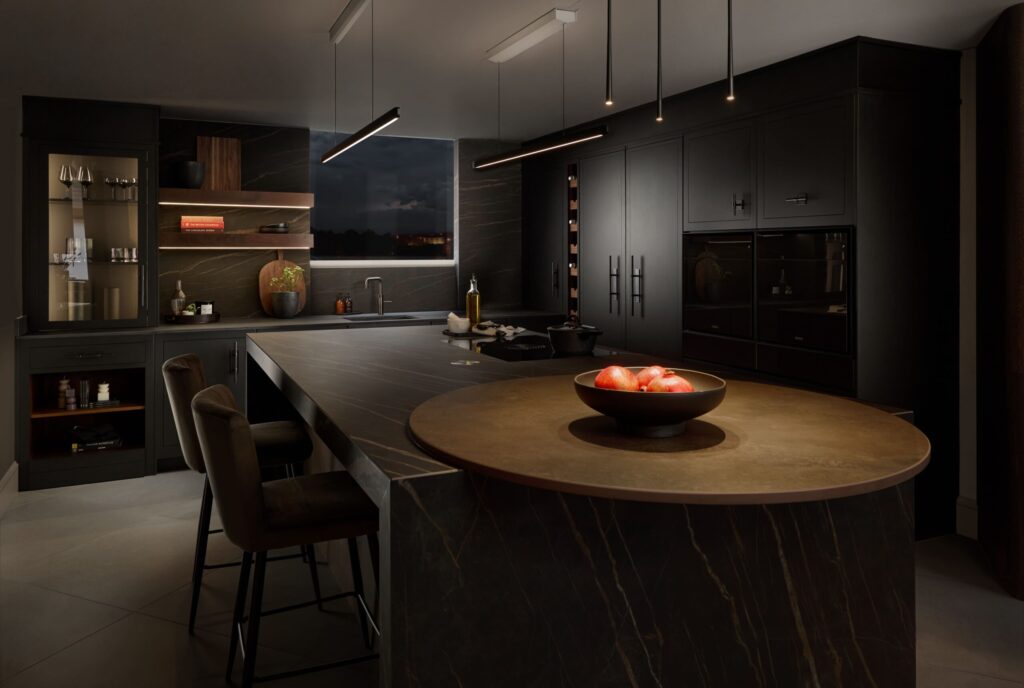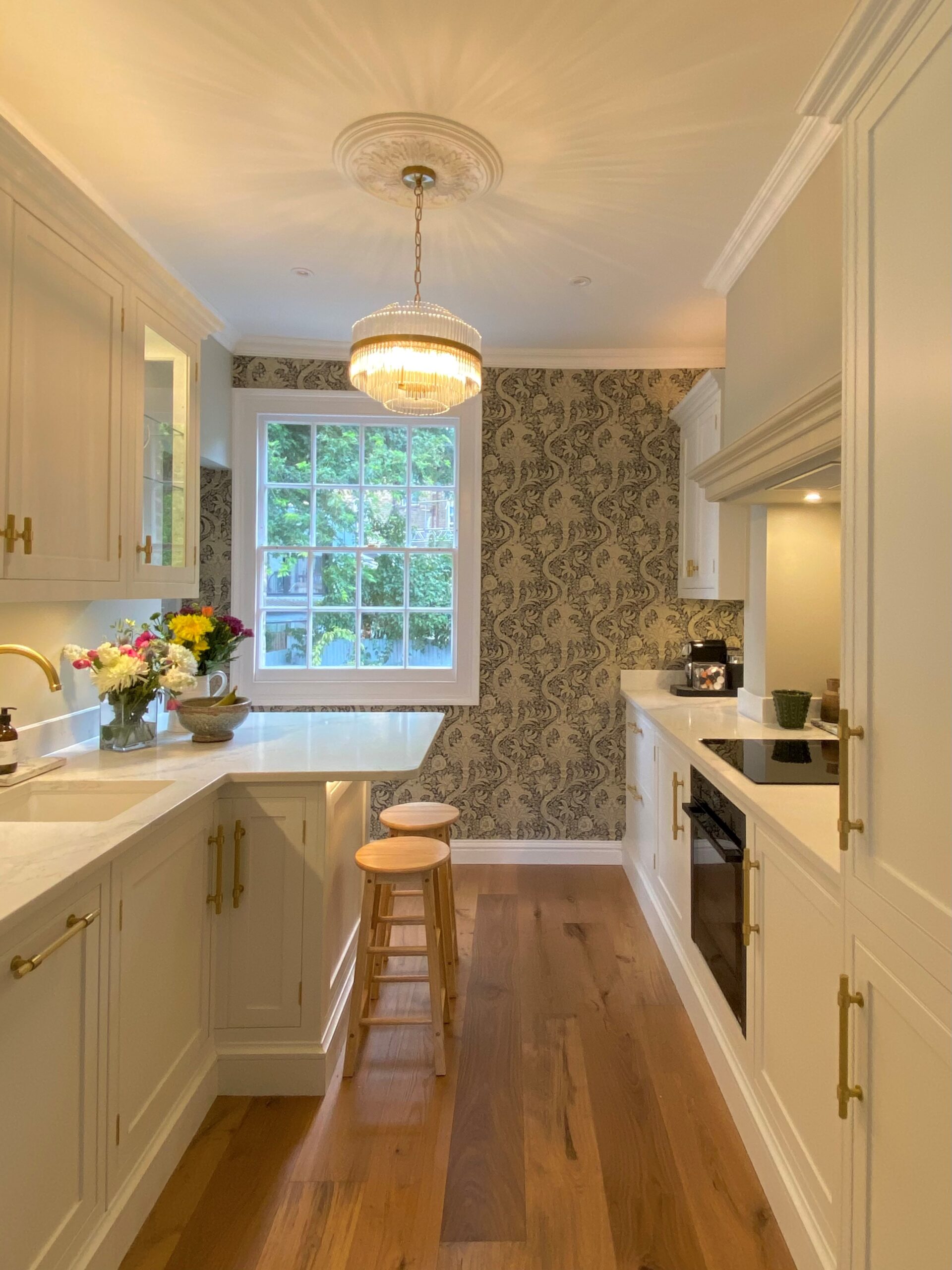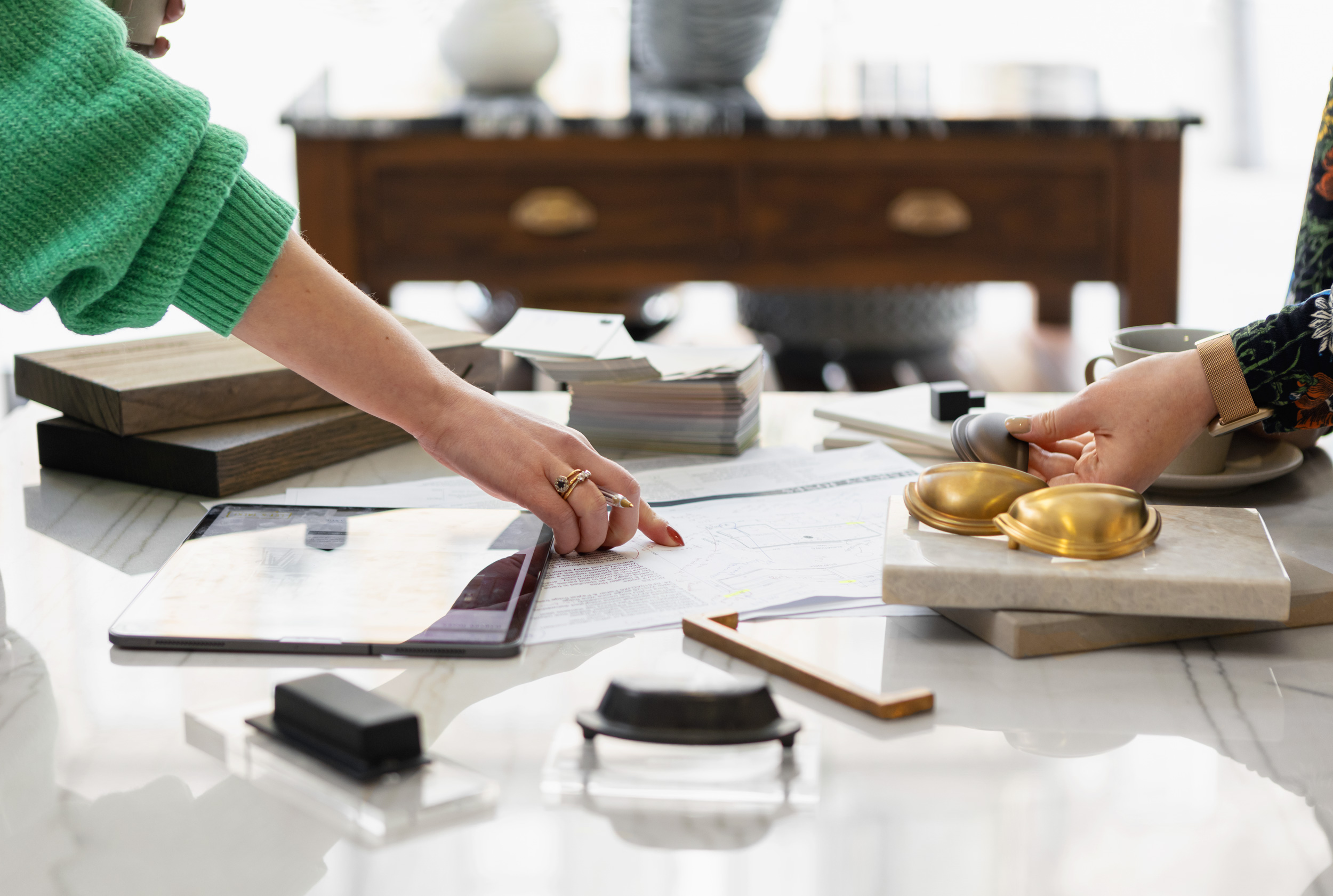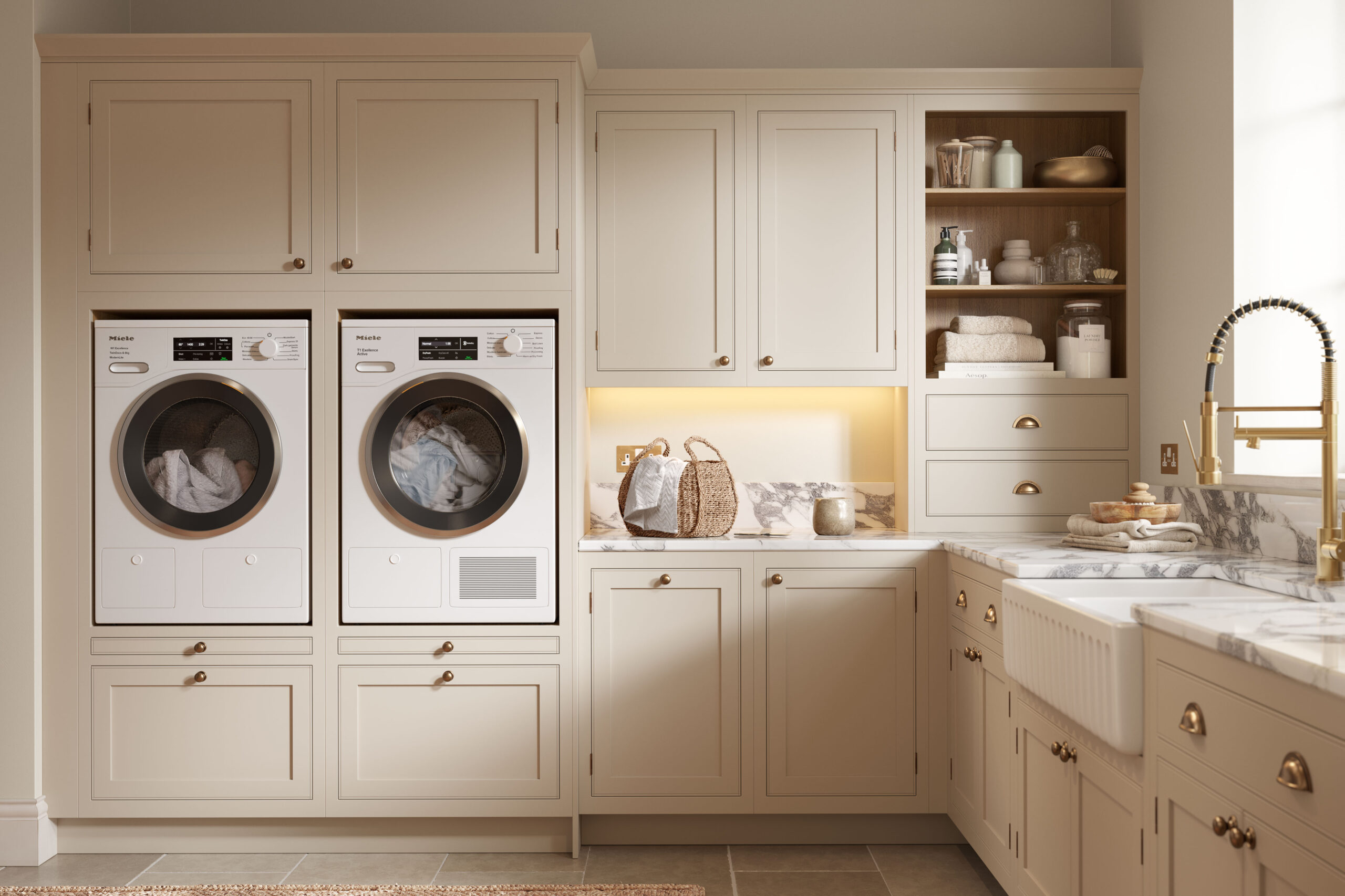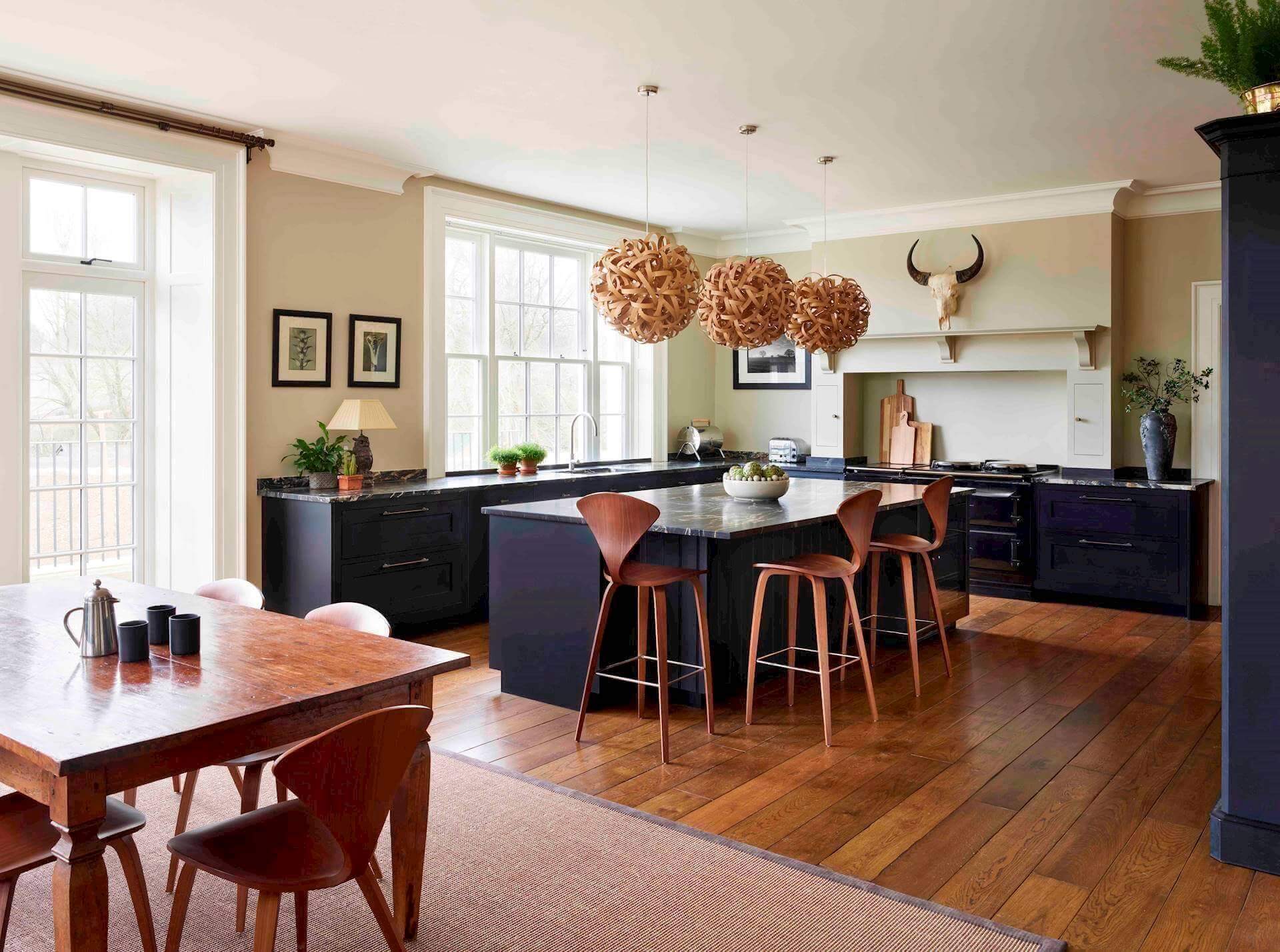
Author: Rachel Davis, Senior Designer at Harvey Jones.
Many homeowners wonder if wooden floors are practical for their kitchens. As a Senior Kitchen Designer at Harvey Jones, I’ve often been asked, “Are wooden floors suitable for kitchens?” The answer is yes, with proper selection and maintenance, wooden floors can be a beautiful and functional choice for your kitchen.
Is it a good idea to have wood floors in the kitchen?
Absolutely, installing wood floors in the kitchen can enhance the space’s warmth and aesthetic appeal. However, it’s essential to consider factors like moisture, foot traffic, and maintenance to ensure longevity and durability.
Four factors to consider when choosing wooden flooring in kitchens
1. Heat and moisture
The kitchen generates a lot of heat and moisture, and as a result can cause warping, swelling and shrinkage in wooden floors, which is why some steer clear of this particular material. Unlike any other room in the house, a wood floor for kitchens is more exposed to these impacts due to fluctuations in temperature and humidity. For example, the warm atmosphere created through cooking meals for your family naturally causes wood to expand and contract.
Despite this, wooden flooring is still a good option for kitchens, provided you control the room’s temperature and humidity. You can do this by ensuring your kitchen is well ventilated, installing an extractor fan and opening windows while preparing food.
2. Appliances
Unless you have a separate utility room, it’s likely your kitchen is home to your washing machine and dishwasher, meaning it’s possible for a leak to occur. If your appliances have been installed correctly you shouldn’t have to worry too much, but if a leak does happen, it has the potential to damage your wooden kitchen flooring. Excessive liquid can also warp the material if it’s not cleaned fast enough.
Your oven is another factor to consider. While most modern fittings are well-insulated and unlikely to cause any issues, an oven that produces a lot of heat may result in gaps appearing in the wood underneath, due to shrinkage and distortion.
3. Spillages
Spills are inevitable in kitchens, especially if there’s little kids running around. If a spillage isn’t wiped up immediately, it may stain or damage your wooden floors. The material is highly absorbent; as soon as something is spilled on it, the wood starts to swell and warp.
The longer the contact, the higher probability of damage, so keep an eye out for spillages when using the kitchen, and invest in some mats around the sink and oven.
4. Location
Wood floors are rustic looking and homely, however, if the kitchen is accessible from your back garden, the material is much more susceptible to wear and tear. Think about your children running through the house from the garden with muddy trainers or dripping wet clothes and hair from the pool — over time, this will impact the condition of your floor.
Although it can be refinished if damage occurs, be mindful of these scenarios before you invest.
What is the best wooden flooring for kitchens?
The best wooden flooring for you will depend on your individual circumstances — here are some of the main possibilities;
1. Solid wood
Solid wood (otherwise known as hardwood) is, as the name suggests, made from nothing but solid planks of wood. Solid wooden floors show the natural beauty of the wood grain and can make any kitchen look more stylish and elegant. This material is also easy to clean and maintain, and is able to be refinished if necessary, overall making it a great choice for your kitchen flooring.
The durability of solid wood is a big selling point too, as it can be sanded down and refinished should the planks start to show signs of wear and tear. That said, it’s not water-resistant, requires daily maintenance and costs more than other flooring options.
We recommend oak, maple or cherry rather than softer types like cedar or redwood for solid wood kitchen floors. Take a look at our dark Shaker Kitchen design that features natural wood flooring, combined with oak cabinets for a contemporary look.
2. Engineered wood
Engineered wood is made from multiple layers of ply that are bonded together to create a strong, stable board, which is then finished with a solid wood lamella. This type of wooden flooring doesn’t expand and contract in the same way that solid wood does, making it a practical choice for your kitchen. It’s perfect to lay on underfloor heating in kitchens, and will also weather the storm of whatever your kitchen throws at it — spills, leaks, foot traffic, you name it.
It’s not completely risk-free though, and engineered wood flooring still requires protection. Any spills or splashes should be mopped up immediately and excessive water on the surface is to be avoided. We also recommend placing felt pads under furniture, lifting items rather than dragging them across the floor, and using maintenance oils!
3. Reclaimed wood
This is a timber flooring that can be purchased in either solid wood or engineered wood. Not only will this offer a great deal of character to your kitchen, it’s also a sustainable option compared to newly manufactured products, helping to reduce the environmental impact of foresting by reusing wood.
Reclaimed pine is a particularly good choice, as it’s naturally clean and light. While teak resists things like rot, insects and decay, ensuring it’s a lifetime material for your kitchen.
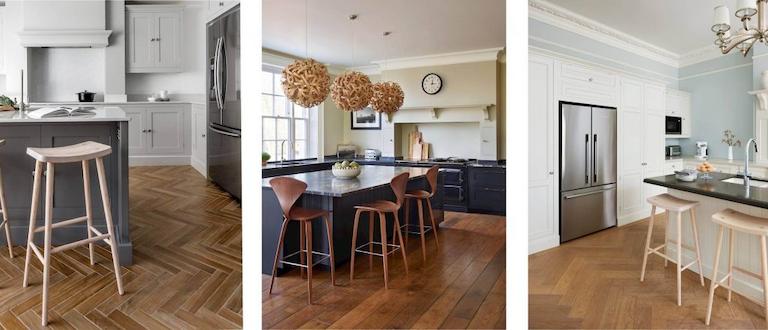
Wood floor alternatives
Yes, wood is a suitable material for kitchen flooring, as long as you keep up with the care and maintenance it demands.
However, we know it’s not practical for every homeowner, either because of budget, specific household requirements or location. High-traffic areas might not be suitable, for example, as wood isn’t always hardest-wearing.
Hope is not completely lost though — the wood look can be created without even using the material. Here are a couple of alternatives:
1. Vinyl
Vinyl kitchen floor tiles offer the high-end finished wood look without the maintenance or expense. Thanks to constantly improving technologies and manufacturing methods, the quality of vinyl is much better than it used to be. It’s highly durable, moisture proof and slip-resistant, meaning if you’ve got youngsters running around the house, it’s also a safe option.
Luxury vinyl tiles are designed with the textures and colours of natural materials in mind, meaning you can achieve the appearance of wood quite easily. This alternative is also simple to care for, as it can just be wiped clean.
2. Laminate
Laminate flooring has been a budget friendly alternative to wood for years. While it won’t look identical, it does create a similar feeling of warmth in your kitchen and doesn’t need as much upkeep. It’s strong, hard-wearing and resistant to scratches and stains too, making it a highly practical option. Spillages are not too much of a concern with laminate flooring either, as some can be 100% waterproof.
There are some downsides though: laminate will never match the simple beauty of real wood, it can’t be refinished and it’s often louder to walk upon than vinyl.
What colour kitchen goes with a wooden floor?
Pairing your wooden floor with the right kitchen colour enhances the overall aesthetic. Consider the following combinations:
Light-Coloured Kitchens
Light-coloured cabinetry, such as whites or creams, creates a bright and open feel. When paired with darker wooden floors, it offers a pleasing contrast that highlights both elements.
Dark-Coloured Kitchens
Dark cabinetry, like navy or charcoal, exudes sophistication. Coupling these with lighter wooden floors balances the depth of the dark colours, preventing the space from feeling too heavy.
Natural Wood Kitchens
or a cohesive and warm look, natural wood cabinets paired with wooden floors can create a seamless and inviting atmosphere. Varying the wood tones slightly adds depth and interest to the design.
How do you care for wood flooring in the kitchen?
Proper care extends the life of your wooden kitchen floors. Here are some maintenance tips:
Regular Cleaning: Sweep or vacuum frequently to remove debris that can scratch the surface. Use a damp (not wet) mop with a cleaner specifically designed for wood floors.
Immediate Spill Management: Wipe up spills promptly to prevent moisture from seeping into the wood and causing damage.
Protective Measures: Place mats near sinks and appliances to catch spills and reduce wear. Use felt pads under furniture to prevent scratches.
Periodic Refinishing: Depending on wear, consider sanding and refinishing your floors every few years to restore their original beauty and provide a fresh protective layer.
Hopefully now you have a better grasp of whether wood floors are suitable for your kitchen. If you’d like some expert advice from our team of kitchen designers about wood floors, don’t hesitate to get in touch with us. Call us on 0800 389 6938 to speak to someone at one of our local showrooms, or request a design consultation here.

